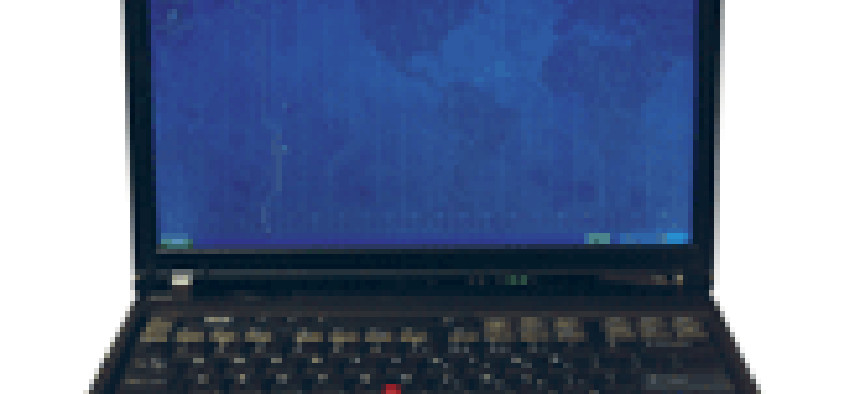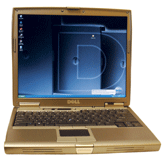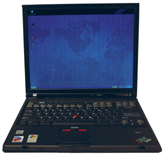If Intel Corp. is to be believed, its new Centrino mobile computing platform, previously codenamed Sonoma, will bring high-end desktop PC performance to notebooks. In the GCN Lab, we don't take anyone's word for granted.The centerpiece of Sonoma is the Intel 915 chip set, which, among other things, supports speedy double data rate 2 memory, a 533MHz frontside bus (up from 400MHz) and, for the first time in notebooks, PCI Express. The overall Centrino platform includes a Pentium M processor and optional Intel Pro/Wireless 802.11a/b/g radio. It also now has a security feature called NX, which works with Windows XP SP2's Data Execution Protection to prevent buffer overflows.No sooner did Intel release Sonoma last month than vendors began sending their first Sonoma-based notebooks to the GCN Lab for review. Dell, Gateway, IBM, Hewlett-Packard, Sharp, Sony and Toshiba all participated. A couple of machines we tested'the Sharp Actius AL3DU and Sony Vaio VGN-FS570'had not yet hit the market when we received them.Our conclusions? Yes, with the new Centrino platform it's possible to enjoy desktop performance in a notebook, but not without intelligent modifications by the vendors.All seven notebooks in our review underwent benchmark testing using the Alterion suite of tests. Alterion uses real-world applications, including Microsoft Excel and Adobe PhotoShop, to test total system performance, particularly the processor and video subsystem.We also put the notebooks through our own battery tests, which represent a worst-case scenario, not typical use. Our battery tests simulate non-stop use of all the major subsystems. We do this because it can be hard to determine typical notebook usage. Therefore battery scores represent the minimum you should expect from these systems.Finally, and for the first time, we put notebooks through the DisplayMate benchmark tests normally reserved for monitors. DiaplayMate measures image quality, namely the notebooks' ability to accurately render different colors and display sharp text at a variety of point sizes.No notebook we tested was unacceptably poor in any area. And several, including the Dell Latitude D610, IBM ThinkPad T43 and Sharp Actius AL3DU, did, in fact, perform as well as or better than the most recent crop of Pentium 4-based desktops we reviewed.But not all of that performance can be attributed to Sonoma. The 915 chip set comes in two flavors'PM and GM. The latter includes Intel's own integrated graphics accelerator. We found notebooks that used the 915GM chip set performed significantly slower than those that included a third-party video chip, such as the ATI Radeon X300 or the Nvidia GeForce Go 6600.Feature-wise, we remain on the lookout for the security functions that government agencies care about, such as the Dell Latitude's integrated smart-card reader, the ThinkPad T43's embedded fingerprint reader and the HP Compaq nc6220's innovative security subsystem. We were also pleased to find three notebooks in this review that include a handy on/off button for deactivating the systems' wireless communications'great for adhering to agencies' wireless policies.To be honest, all seven notebooks impressed us in one way or another. But two'the Dell and the Sharp'were our favorites. Top performance, excellent graphics, integrated smart-card reader Poor battery lifeThe Dell Latitude D610 does, in fact, run like a Pentium 4 desktop. With a 2GHz Pentium M processor and 512M of DDR2 memory, the D610 turned in an Alterion benchmark score of 8,210, which is nearly identical to what a 3.2GHz Pentium 4-based Dell OptiPlex earned last August.Dell went with the PM version of the Intel 915, which means it skipped Intel's own integrated graphics chip in favor of a state-of-the-art ATI Mobility Radeon X300 accelerator. Paired with an exceptional SXGA-plus display, which has a native resolution of 1,400 by 1,050 pixels, the D610's graphics system performed well in our DisplayMate benchmark tests, particularly when it came to producing crisp, legible text.The D610 uses the Intel Pro/Wireless 2200 card, which supports IEEE 802.11b/g connectivity, and includes an integrated smart-card reader for client security. If the system has an Achilles' heel, it's battery life. On a full tank, the Dell lasted just one hour and 30 minutes in our tests'easily the shortest battery life of the notebooks we reviewed. And it may be nitpicky at this stage, but the Dell doesn't come with a one-touch button for turning off the system's wireless communications.Overall, though, we were impressed with the combination of performance and features that Dell put into this affordable, $1,746 notebook, including four USB ports for your various peripherals. The Latitude D610 should be at the top of your list when it comes time for new notebooks.Dell Inc., 800-999-3355, Exceptional battery life for the price Poor performanceThe Gateway M460 makes for a tale of two notebooks. On the one hand, it earned the lowest score in our Alterion benchmark tests; on the other, its battery lasted twice as long as other systems we tested. At $1,624 it's easy on the budget, but it doesn't come with some of the bells and whistles of other notebooks tested.Our M460 test system had a 1.6GHz Pentium M processor and embedded Intel GMA 900 video accelerator, which may explain its lowly 5,531 Alterion test score. The notebook was noticeably slower than others we used, and it lagged the competition in displaying bright, crisp colors and text.The M460 includes the Intel Pro/Wireless 2200 802.11b/g network interface and a memory card slot that supports SecureDigital, Multimedia Card and Memory Stick. And it comes with a slew of ports, including one FireWire and four USB ports. But it doesn't have the government-specific tweaks we'd like to see, such as built-in user authentication or wireless power-down features.Except for its remarkable five-hour battery life, which it accomplishes with a 12-cell battery (the Dell, in comparison, has a six-cell battery), there isn't much that makes the M460X stand out. If you're willing to compromise to get a long-lasting, inexpensive notebook, the Gateway makes sense.Gateway Inc., 888-221-9616, Great security features, good color screen Poor performanceAlthough the HP Compaq nc6220 received the second-lowest Alterion benchmark score (5,938) of this review, its state-of-the-art security features, solid two-hour-and-46-minute battery life, and strong DisplayMate graphics results make it a good buy for most agency users.As we found with Gateway M460X, relying on Intel's integrated graphics chip may be a liability. Despite a 2GHz Pentium M processor and 512M of DDR2 RAM, the nc6220 didn't perform as well as expected. (The Sony Vaio reviewed on Page 44 also comes with Intel graphics and turned in a subpar score.) On our DisplayMate tests, the system produced above-average color images, but its text wasn't as legible as other systems' when using smaller fonts.Despite these drawbacks, the nc6220 has several security features and other innovations that make it worth a second look. It comes with firmware that allows password protection at a preboot level. Combined with separate password protection that locks the hard drive when it's removed and an embedded smart-card reader, the nc6220's security is among the best around.The system also comes with a SecureDigital memory slot, three USB ports and (eureka!) a wireless on/off switch. Another smart little feature: The nc6220 family has a port on the bottom of the notebook for connecting a second battery so users don't have to swap out their optical drive.Feature-for-feature, the nc6220 holds its own against any notebook, and at a GSA price of $1,880 for the model we tested, it's affordable. If it performed better, we'd recommend it.Hewlett-Packard Co., 800-752-0900, [IMGCAP(2)] Excellent performance, integrated fingerprint reader Poor display quality, limited peripheral supportThere's a lot to like about the ThinkPad T43, not the least of which is an embedded fingerprint reader that you swipe to gain access to the system. It's also exceptionally fast, with a 1.8GHz Pentium M processor, 512M of DDR2 memory and an ATI Radeon X300 video accelerator. But as you may have come to expect, you don't get the ThinkPad touches, such as the slim design and lighted keyboard, without paying a price'in this case $2,067.We're not sure we'd pay that price. Although the T43 turned in one of the best battery performances of this review, at two hours, 45 minutes, other features left us wanting. For example, the T43 comes with a lot of management software to control everything from security to battery performance. But there isn't a single, easy-to-use interface to guide people. And we were unimpressed by the 14.1-inch display, which produced sharp text but dark, dull colors.Our test system came with an Atheros tri-mode wireless chip that supports 802.11a/b/g connectivity. But we would have liked more than just two USB ports for adding peripherals.As the saying goes, no one ever got fired for buying IBM, and jobs are safe with the powerful, lightweight ThinkPad T43. But in light of gains made by other notebook makers, ThinkPad isn't the undisputed top dog it once was.IBM Corp., 800-426-4968, Blazing speed, excellent display Expensive, short battery lifeNormally we'd kick off this review with a disclaimer: Sharp gave the GCN Lab a first look at the latest Sonoma-based Actius AL3DU notebook before launching it March 8, therefore the company can be forgiven temporarily for any glitches. But we don't need to; this is one of the best notebooks we've had in the lab.The AL3DU is a big improvement over previous Sharp notebooks, including the RD3D. It has a white, futuristic design that resembles a cross between an Apple iBook and a Sony Vaio. The new keyboard has a subtle ergonomic bend that doesn't require the user to relearn typing or cause undue stress on the wrists.Performance-wise, the AL3DU is flat-out fast, notching the top Alterion benchmark score (8,477) of the notebooks we tested. It came with a 1.8GHz Pentium M processor, 1G of DDR2 RAM and a 128M Nvidia GeForce Go 6200 video accelerator. The system also excelled in our DisplayMate tests, producing bright colors and sharp text. In fact, the AL3Du was designed to render cutting-edge graphics. By pressing a special button, you can initiate a 3-D filter behind the 15-inch display that basically separates an image into two parts, projecting each separately and giving the illusion of three dimensions.We also liked several other touches, including a dual-boot feature with Debian GNU/Linux and Windows XP operating systems, three USB ports and a FireWire port. Our model didn't have the wireless interface installed, but Sharp says the shipping models have built-in WiFi.Granted, two hours and 10 minutes is on the low end of notebook battery life, but it's above two hours'our arbitrary Mendoza line. And $3,499 is a lot to pay for a notebook, but that figure covers the extra RAM and a 120G hard drive. In our opinion, the AL3DU is something of a notebook dream machine. If you can play with the configuration enough to get the cost down (without cutting high-performance components such as the Nvidia accelerator), you'll have a top-notch system in your bag.Sharp Systems of America, 714-903-4600, Great graphics and image display Sluggish performance, short battery lifeWe expect the finest frills from a Sony notebook, and the sleek Vaio VGN-FS570 doesn't disappoint. It's well designed, with a DVD+/-RW optical drive, wireless on/off button and a bright, beautiful 15.4-inch wide-screen display. Sony even includes its proprietary XBrite video technology, normally found on Sony LCD monitors, which helped the system turn in top marks across the board in our DisplayMate tests.But looks can be deceiving. For some reason, Sony settled for the integrated Intel GMA 900 video chip to drive its impressive LCD. Although applications appear nice, the overall system is sluggish. The Vaio's Alterion benchmark score of 6,114 is only slightly better than the slowest notebooks we tested. And the system's battery lasted less than two hours.Our $1,999 test notebook came with 1G of slower DDR memory and a 90G hard drive. Unfortunately, the Vaio's performance does not justify the cost. Half the RAM and a smaller hard drive would shave a few hundred dollars off the price. We would also be surprised if Sony didn't upgrade this model to include the latest memory technology and a better video subsystem. For now, there are better notebooks available.Sony Electronics Inc., 800-571-7669, Good performance Noisy, just two USB portsThe Tecra M3-S331 reminds us of the Gateway M460, only better. It doesn't have features that blow us away (in fact, we wish it came with more than two USB ports for connecting peripherals). But it performs above average and has an attractive $1,799 GSA price tag.With a 1.73GHz Pentium M processor, 512M of DDR2 RAM and a 64M Nvidia GeForce Go 6200 graphics chip, the Tecra logged a respectable 7,634 Alterion benchmark score. Its two-hour and 35-minute battery life was better than much of the competition, and its DisplayMate tests placed its LCD quality just a notch below the best notebooks we reviewed. We were impressed by the Tecra's ability to display rich colors.Like the HP Compaq nc6220 and Sony Vaio VGN-FS570, the Tecra comes with a sensible switch for turning the Intel Pro/Wireless 2200 radio on or off. Our only significant design complaint is that our test unit consistently emitted unsettling noise from its side. As Toshiba ships more Tecra systems, we expect that issue to be a non-factor.Overall, thanks to solid performance and features, the Tecra M3-S331 earned good marks. In the end, though, we liked other notebooks more.Toshiba America Information Systems Inc., 800-316-0920,
New Intel Sonoma mobile platform means more speed for portable computersWhat we didWhat we foundDell Latitude D610Pros:








